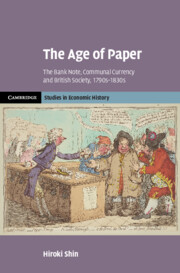Book contents
- The Age of Paper
- Reviews
- Cambridge Studies in Economic History
- The Age of Paper
- Copyright page
- Contents
- Figures and Illustrations
- Tables
- Acknowledgements
- Abbreviations
- Introduction
- 1 The Beginning of the Bank Restriction Period
- 2 The Users of the Bank of England Note
- 3 The Registers of Paper-Currency Use
- 4 Gold, Gold, Gold
- 5 The Forgery Crisis and the Radicalisation of Communal Currency
- 6 Resumption and Its Aftermath
- Conclusion
- Bibliography
- Index
4 - Gold, Gold, Gold
The Legal Tender Question and the Bullionist Controversy
Published online by Cambridge University Press: 19 December 2024
- The Age of Paper
- Reviews
- Cambridge Studies in Economic History
- The Age of Paper
- Copyright page
- Contents
- Figures and Illustrations
- Tables
- Acknowledgements
- Abbreviations
- Introduction
- 1 The Beginning of the Bank Restriction Period
- 2 The Users of the Bank of England Note
- 3 The Registers of Paper-Currency Use
- 4 Gold, Gold, Gold
- 5 The Forgery Crisis and the Radicalisation of Communal Currency
- 6 Resumption and Its Aftermath
- Conclusion
- Bibliography
- Index
Summary
Chapter 4 reinterprets the celebrated debate on monetary theory and policy, the Bullionist Debate, by embedding the episode within the social context of wartime Britain and by identifying the continuing relevance of the communal-currency idea in parliamentary debate, the legal court and contemporary publications. It traces the development of politico-theoretical debate about paper currency from the 1790s up to the late 1800s, when paper currency was predominantly discussed from the communal perspective, despite the growing influence of metallist theory. It then turns to the legal cases of coin sales as a challenge to the inconvertible currency system, which were also entangled with French economic warfare through illegal smuggling of precious metal. This chapter considers the high-profile 1810 parliamentary report on currency for its practical implications for the Bank’s engagement in monetary policy. Contemporary legal cases made the new legislation on ‘forced’ circulation of paper – the Stanhope Act – an urgent issue in parliament. This legislation to protect inconvertible currency, however, undermined the communal and voluntary foundations of Britain’s paper currency.
Keywords
- Type
- Chapter
- Information
- The Age of PaperThe Bank Note, Communal Currency and British Society, 1790s–1830s, pp. 145 - 190Publisher: Cambridge University PressPrint publication year: 2025

